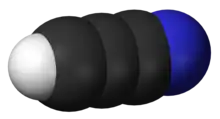Cyanoacetylene
Cyanoacetylene is an organic compound with formula C3HN or H−C≡C−C≡N. It is the simplest cyanopolyyne. Cyanoacetylene has been detected by spectroscopic methods in interstellar clouds,[2] in the coma of comet Hale–Bopp and in the atmosphere of Saturn's moon Titan,[3] where it sometimes forms expansive fog-like clouds.[4]
 | |
| Names | |
|---|---|
| Preferred IUPAC name
Prop-2-ynenitrile | |
| Other names
Propiolonitrile Cyanoethyne Monocyanoacetylene 2-Propynenitrile | |
| Identifiers | |
3D model (JSmol) |
|
| ChemSpider | |
PubChem CID |
|
| UNII | |
CompTox Dashboard (EPA) |
|
| |
| |
| Properties | |
| C3HN | |
| Molar mass | 51.048 g·mol−1 |
| Melting point | 5 °C (41 °F; 278 K) |
| Boiling point | 42.5 °C (108.5 °F; 315.6 K) |
Except where otherwise noted, data are given for materials in their standard state (at 25 °C [77 °F], 100 kPa).
Infobox references | |
Cyanoacetylene is one of the molecules that was produced in the Miller–Urey experiment.[5]
See also
- Dicyanoacetylene, N≡C−C≡C−C≡N
- Diacetylene, H−C≡C−C≡C−H
- Cyanogen, N≡C−C≡N
- Hydrocyanic acid, H−C≡N
- Polyyne, R−(C≡C)n−R
References
- Murahashi, Shunsuke; Takizawa, Takeo; Kurioka, Shohei; Maekawa, Seiji (1956). "Cyanoacetylene. I. The synthesis and some chemical properties". Nippon Kagaku Zasshi. 77 (11): 1689–1692. doi:10.1246/nikkashi1948.77.1689.
- Solomon, Philip M. (1973). "Interstellar molecules". Physics Today. 26 (3): 32–40. Bibcode:1973PhT....26c..32S. doi:10.1063/1.3127983.
- H. B. Niemann; et al. (2005). "The abundances of constituents of Titan's atmosphere from the GCMS instrument on the Huygens probe" (PDF). Nature. 438 (7069): 779–784. Bibcode:2005Natur.438..779N. doi:10.1038/nature04122. hdl:2027.42/62703. PMID 16319830. S2CID 4344046.
- de Lazaro, Enrico (November 11, 2015). "Cassini Detects Giant Cloud of Frozen Compounds on Saturn's Moon Titan". Sci News.
- Ehrenfreund, P.; Irvine, W.; Becker, L.; Blank, J.; Brucato, J. R.; Colangeli, L.; Derenne, S.; Despois, D.; Dutrey, A.; Fraaije, H.; Lazcano, A.; Owen, T.; Robert, F.; Issi-Team, an International Space Science Inst (2002). "Astrophysical and Astrochemical Insights into the Origin of Life". Reports on Progress in Physics. 65 (10): 1427–1487. Bibcode:2002RPPh...65.1427E. doi:10.1088/0034-4885/65/10/202.
This article is issued from Wikipedia. The text is licensed under Creative Commons - Attribution - Sharealike. Additional terms may apply for the media files.
